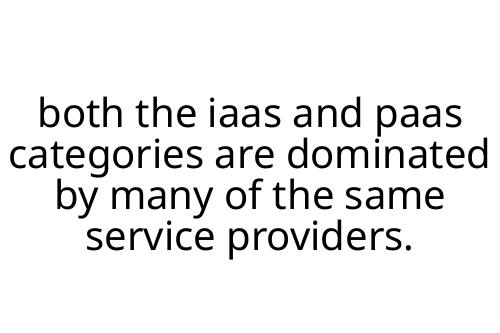both the iaas and paas categories are dominated by many of the same service providers.
When you look at today’s cloud computing landscape, it becomes clear that both the iaas and paas categories are dominated by many of the same service providers. Tech giants like Amazon Web Services (AWS), Microsoft Azure, and Google Cloud Platform (GCP) consistently lead the market. Understanding why these providers excel in both Infrastructure as a Service (IaaS) and Platform as a Service (PaaS) can help businesses make practical cloud decisions.
Why the Overlap Exists
The main reason for this domination is scale. Running data centers across the globe allows these providers to offer both raw infrastructure (IaaS) and managed platforms (PaaS). They have the capital, expertise, and existing customer base to branch out into adjacent services. For example, AWS initially focused on IaaS offerings like EC2 and S3 but quickly expanded into PaaS options like Elastic Beanstalk and Lambda.
The Leading Service Providers
Let’s break down the most prominent players:
- Amazon Web Services (AWS): The biggest name in the cloud, AWS leads in both IaaS with EC2, VPC, S3, and also PaaS with Elastic Beanstalk, AWS Lambda, and RDS.
- Microsoft Azure: Known for its smooth integration with Microsoft’s legacy software, Azure offers virtual machines and networking (IaaS) and managed databases, App Services, and Azure Functions (PaaS).
- Google Cloud Platform (GCP): GCP has made a name for itself with flexible compute options and AI features (IaaS), as well as App Engine and Cloud Functions (PaaS).
Some other notable providers—like IBM Cloud, Oracle Cloud, and Alibaba Cloud—also supply both IaaS and PaaS, but on a smaller global scale.
Pros and Cons of Using the Same Provider
Pros
- Integration: Sticking with one cloud for both IaaS and PaaS often means better integration. Services talk to each other easily.
- Simplified Billing: One invoice, less administrative burden.
- Support: Unified support channels streamline troubleshooting.
Cons
- Vendor Lock-In: Relying heavily on one provider can make switching costly and complex later.
- Less Specialized Choices: Dominant providers may not always have the niche features or customization offered by smaller specialists.
Choosing the Right Cloud Strategy
If you’re deciding between providers for IaaS and PaaS, consider your priorities. If integration, support, and long-term stability matter, the larger providers are reliable choices. However, if you need something specific—like unique database options, custom hosting, or specialized compliance needs—it may be worth looking at smaller, more focused providers, even if it means splitting your infrastructure.
Practical Tips
- Evaluate Your Workloads: Not all workloads need both IaaS and PaaS from the same provider. Mix-and-match is an option.
- Start Small: Try running a pilot project before committing to a single provider for all your needs.
- Read the Fine Print: Understand SLAs, data egress fees, and support tiers—these vary even among the major players.
Final Thoughts
In short, both the iaas and paas categories are dominated by many of the same service providers because scale, resources, and a global presence matter in the cloud world. For most organizations, starting with a major provider makes sense, but don’t forget to weigh the potential trade-offs. Stay objective about what fits best for your workload and long-term needs.


 Steven Alfonso – Senior Gambling Analyst
Steven Alfonso serves as the Senior Gambling Analyst at Gamble Wise Roll, bringing a wealth of industry knowledge and analytical expertise to the platform. With a background in gaming economics and market research, Steven delves into the latest trends shaping the gambling world, from emerging skill-based betting opportunities to regulatory shifts and technological advancements. His in-depth reports provide a comprehensive look at how the industry is evolving, offering valuable insights for both casual players and seasoned professionals. Passionate about data-driven decision-making, Steven ensures that Gamble Wise Roll remains at the forefront of industry analysis, helping readers understand the risks, opportunities, and strategies that define modern gambling.
Steven Alfonso – Senior Gambling Analyst
Steven Alfonso serves as the Senior Gambling Analyst at Gamble Wise Roll, bringing a wealth of industry knowledge and analytical expertise to the platform. With a background in gaming economics and market research, Steven delves into the latest trends shaping the gambling world, from emerging skill-based betting opportunities to regulatory shifts and technological advancements. His in-depth reports provide a comprehensive look at how the industry is evolving, offering valuable insights for both casual players and seasoned professionals. Passionate about data-driven decision-making, Steven ensures that Gamble Wise Roll remains at the forefront of industry analysis, helping readers understand the risks, opportunities, and strategies that define modern gambling.
